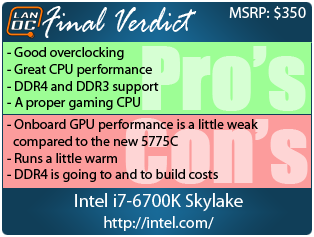Well if it feels like I was just here talking about a newly launched Intel CPU it is because, well, I was. Intel ran into a few issues with their Broadwell launch and those issues pushed its launch back significantly. Well to their credit they didn’t let those issues slow down the Skylake launch, so today they are launching their new flagship consumer CPU at Gamescom. The reason they are launching there is because the first part of the Skylake launch is completely focused on gamers and overclockers. They are only launching two SKUs, their i7-6700K and the i5-6600K. Both are overclockable, high clock speed CPUs focused right at enthusiast and gamers who want to get the best possible performance without the heavy investment that an X99 build would cost them.
Product Name: Intel i7-6700K Skylake
Review Sample Provided by: Intel
Written by: Wes
Pictures by: Wes
Amazon Link: HERE
| Specifications | ||
| Model | I7-6700K | I5-6600K |
| Microarchitecture | 14nm | 14nm |
| Process Node | Skylake | Skylake |
| TDP | 91W | 91W |
| Cores/Threads | 4/8 | 4/4 |
| CPU Base Freq (GHz) | 4.0GHz | 3.5GHz |
| Max Turbo Freq (GHz) | 4.2GHz | 3.9GHz |
| Memory | 2 Channels DDR4-2133 DDR3L-1600 |
2 Channels DDR4-2133 DDR3L-1600 |
| L3 Cache | 8MB | 6MB |
| Onboard GPU | Intel HD Graphics 530 | Intel HD Graphics 530 |
| Graphics Max Frequency | 1150MHz | 1150MHz |
| PCI Express 3.0 Lanes | 16 | 16 |
| Socket | LGA 1151 | LGA 1151 |
| MSRP | $350 | $249 |
Skylake
While most of the Intel Broadwell launch was focused on mobile, it was the introduction of the 14nm process node for Intel. Continuing to follow their Tick/Tock release schedule Skylake runs on that same process node but is their new architecture. This new architecture brings along a few changes. The biggest change is the move to DDR4 on the consumer platform. The X99 launch introduced us to DDR4 but Intel is now working on moving the rest of their lineup over. This is a huge deal for a lot of you, its easy to get used to being able to carry your ram over when upgrading your PC so on top of the cost of a new motherboard and CPU you are going to need DDR4. Lucky for you though, Skylake does still support DDR3 in the built in memory controller so motherboard manufactures have the option to go DDR4 or DDR3. I love the idea of the dual support but with DDR4 prices already dropping I have a feeling motherboard manufactures are going to focus more on DDR4, but we will see. For the onboard video Intel is introducing their Intel HD Graphics 530 GPU on both of the K series CPUs being introduced today.
So I would first like to point out that typically we would receive a crazy amount of information that dives down into every part of the architecture but this time around Intel is keeping things really quiet so the details on what set Skylake apart from Haswell are slim. I get the impression that they are planning a few big surprises with the introduction of the rest of the product line later this year so we will learn more than. So with Intel launching just the two CPUs today, what sets them apart? Well we have the i7-6700K that I will be testing today and the i5-6600K. I love that they have gone back to the old school naming scheme for this launch, it reminds me of the 2600K/2500K launch that are still very popular. The 6700K, like other i7 CPUs, has hyperthreading where the 6600K does not. They also gave it an additional 2MB cache for a total of 8MB. Both processors have a TDP of 91 watts but the 6700K has a much higher base clock (4GHz vs 3.5GHz), their max turbo frequencies are a little closer but with the 6700K (of course) being a little faster (4.2GHz vs 3.9GHz).

Both CPUs come with Intels new HD Graphics 530, again the details are hard to come by but from what we can see the new onboard has four more execution units when compared to Haswell going from 20 to 24. It counteracts that slightly with a slightly slower clock speed though (1150MHz to 1200MHz on Haswell). We will have to see in testing how it performs, but we all know that the enthusiasts and gamers who these CPUs are focused will mostly be running dedicated GPUs anyhow. The only other big change that can be found in the processor architecture block diagram was the upgraded DMI 3.0. The DMI 2.0 had four 5 GT/s lanes routed between the CPU and the PCH. The new DMI 3.0 has four 8 GT/s lanes for a big bump in bandwidth. For those of you who don’t know what the DMI does, it is the link between the Northbridge and Southbridge.
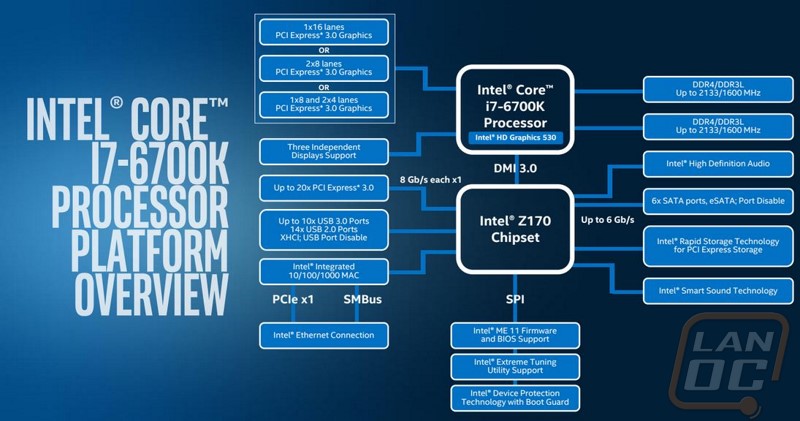
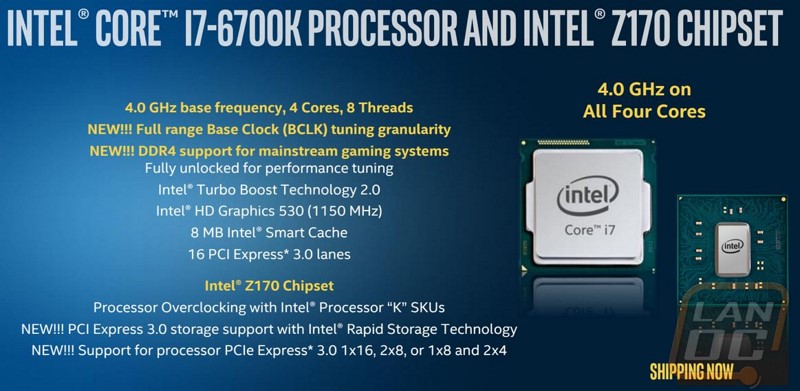
Intel sent along photos of the packaging for the new Skylake CPUs and I was a little blown away at just how bright and flashy they went. One thing is for sure, you won’t miss them on the shelf. You also will know if you are getting an i5 or an i7 given how large that is on the cover. Hopefully they make it that easy to find out the specific model as well because I’m sure this is only the tip of the iceberg for Skylake CPUs.
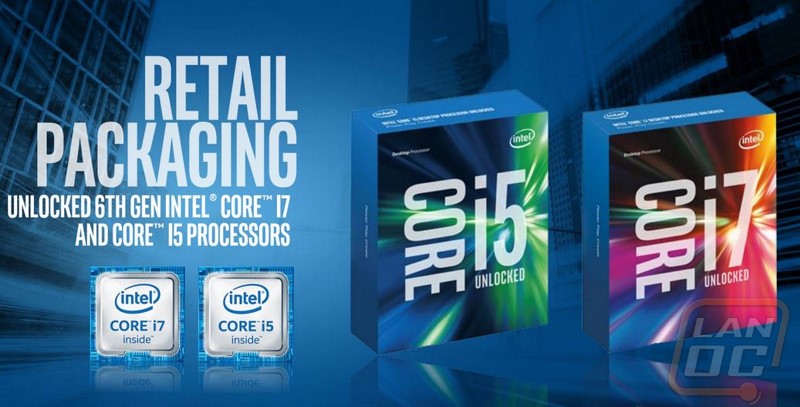
As far as form factor, the new Skylake CPUs are officially using a new LGA 1151 socket. But when you put the i7-6700K next to the i7-4770 they share the same heat spreader and overall size. The thickness of the PCB is thinner than the 4770K and they made up the difference in a slightly thicker heat spreader but it is hardly noticeable from any direction except for the side. It really isn’t until you look very close that you can see that the small indents on the sides of the PCB near the top have moved. They did this to prevent people from putting the CPUs into an unsupported motherboard. On the underside we still have the same flat contact design that relies on the pins being on the motherboard. They did fill in a few of the gaps and added what looks to be like 20 more contacts this time around as well. I wonder if those are to support the dual DDR4 and DDR3 support.





Speaking of DDR4, with the move to DDR4 I did have to upgrade our testbench. For years now I have been using the same 1600MHz blue Kingston HyperX DDR3 sticks. Well given our great luck with Kingston we went with them once again for the dual channel DDR4 but this time we went with their newer Fury line in a black that matches most boards better. We stepped up to a 16GB kit over 8GB and went with their 2666MHz model. For our test motherboard I’m using the Z170A Gaming M5 from MSI, but I will go into it in more depth with a full review over the next few days!




Our Test Procedures and Test Benches
| Our CPU Test Benches for each CPU tested | |
| Intel Socket 1151 (Skylake) |
MSI Z170A Gaming M5 Kingston HyperX 3000K 240GB SSD Kingston HyperX FURY 16GB DDR4 Noctua NH-U12S heatsink Thermaltake Grand 850W PSU Nvidia GTX 780 Video Card Dimastech Test Bench |
| Intel Socket 1150 (Broadwell) |
MSI Z97 Gaming 9 AC Kingston HyperX 3000k 240GB SSD Kingston HyperX 8GB 1600MHz DDR3 RAM Noctua NH-U12S heatsink Thermaltake Grand 850W PSU Nvidia GTX 780 Video Card Dimastech Test Bench |
| AMD Socket AM3+ |
Asrock Fatal1ty 990FX Professional Kingston HyperX 128GB SSD Kingston HyperX 8GB 1600MHz DDR3 RAM Noctua NH-U14S heatsink Cooler Master V1000 Power Supply Nvidia GTX 780 Video Card Microcool Banchetto 101 Test bench |
| Intel Socket 2011v3 (Haswell-E) |
Asus X99-Deluxe Corsair Vengeance LPX 2666MHz DDR4 4x4GB OCZ Vector 150 120GB SSD Western Digital Velociraptor 600GB HDD (for steam) Thermaltake Grand 850W PSU Noctua NH-U12S heatsink Nvidia GTX 780 Video Card Dimastech Test Bench |
| AMD Socket FM2+ |
Asus A88-Pro Kingston HyperX 128GB SSD Kingston HyperX 8GB 1600MHz DDR3 RAM Noctua NH-U14S heatsink Cooler Master V1000 Power Supply Nvidia GTX 780 Video Card Microcool Banchetto 101 Test bench |
| AMD Socket FM2 |
Asus F2 A85-V Pro OCZ Agility 3 120GB SSD Kingston HyperX 8GB 1600MHz DDR3 RAM Noctua NH-U14S heatsink Cooler Master V1000 Power Supply Nvidia GTX 780 Video Card Microcool Banchetto 101 Test bench |
| Intel Socket 1150 (Devil’s Canyon) |
Asus Z97-A Kingston HyperX 3000k 240GB SSD Kingston HyperX 8GB 1600MHz DDR3 RAM Noctua NH-U12S heatsink Cooler Master V1000 Power Supply Nvidia GTX 780 Video Card Microcool Banchetto 101 Test bench |
| Intel Socket 1150 (Haswell) |
MSI Z87-G45 Gaming Kingston HyperX 128GB SSD Kingston HyperX 8GB 1600MHz DDR3 RAM Noctua NH-U12S heatsink Cooler Master V1000 Power Supply Nvidia GTX 780 Video Card Microcool Banchetto 101 Test bench |
| Intel Socket 1155 (Ivy Bridge) |
Crucial Ballistix Tracer Ram 1600Mhz 2x2Gb Intel DZ77GA-70K OCZ Agility 3 120Gb SSD Noctua NH-C14 heatsink Cooler Master Silent Pro M 850Watt PSU Two Nvidia GTX580’s for SLI testing Microcool Banchetto 101 Test bench |
| Intel Socket 2011 (Sandy Bridge-E) |
Intel DX79SI Motherboard Kingston HyperX DDR3 1600MHz Quad Channel Ram Two Kingston HyperX SATA 3 SSD’s in RAID 0 Intel Active Thermal Solution RTS2011LC Water-cooling Cooler Master Silent PRO Gold 1200w PSU Nvidia GTX 780 Video Card Highspeedpc Test Bench |
| Intel Socket 1155 (Sandy Bridge) |
Crucial Ballistix Tracer Ram 1600Mhz 2x2Gb FATAL1TY P67 Profess1onal Series Motherboard OCZ Agility 60Gb SSD Noctua NH-C14 heatsink Cooler Master Silent Pro M 850Watt PSU Sapphire HD6970 BF:BC2 Edition for AMD testing Two Nvidia GTX580’s for SLI testing Microcool Banchetto 101 Test bench |
| Intel Socket 1366 |
Gigabyte G-1 Assassin Gaming Motherboard EVGA Classified GTX580 Video card Cooler Master HAFX Nvidia Edition Case Crucial Ballistix Tracer DDR3 Ram 1600MHz Cool-It Water-cooling Cooler Master Silent PRO Gold 1200w PSU Western Digital SiliconEdge Blue SSD |
| CPU Testing Procedures | |
| Bioshock Infinite | Adrenaline Action Benchmark Tool on the “Xtreme” quality setting. |
| Tomb Raider | Adrenaline Action Benchmark Tool on the “Xtreme” quality setting. |
| Hitman: Absolution | Adrenaline Action Benchmark Tool on the “Xtreme” quality setting. |
| Sleeping Dogs | Adrenaline Action Benchmark Tool on the “Xtreme” quality setting. |
| 3DMark Fire Strike | Physics Score – Performance benchmark |
| wPrime | 1024M and 32M |
| X264 HD Benchmark | Pass 1 and Pass 2 |
| Cinebench | CPU and CPU (Single Core results) |
| Passmark 8 | CPU Mark Score |
| PCMark 7 | Full benchmark Suite |
| Power Usage | Idle and load testing using a Kill-A-Watt and Wprime to put the cpu under load |
| PCMark 8 | Home test is run both with and without OpenCL |
| Temps | Prime95 to load, motherboard software to read temperature |
| Onboard Testing Procedures | |
| Bioshock Infinite | Adrenaline Action Benchmark Tool on the “Medium” quality setting at 1080p |
| Tomb Raider | Adrenaline Action Benchmark Tool on the “Medium” quality setting at 1080p |
| Hitman: Absolution | Adrenaline Action Benchmark Tool on the “Medium” quality setting at 1080p |
| Sleeping Dogs | Adrenaline Action Benchmark Tool on the “Medium” quality setting at 1080p |
| 3DMark Fire Strike | Performance setting – GPU Score |
| Unreal Heaven Benchmark 4.0 | Extreme preset |
| Unreal Valley Benchmark 1.0 | Extreme HD Preset |
| F1 2013 | Ultra Preset |
| Cinebench R11.5 | OpenGL benchmark |
| Cinebench R15 | OpenGL benchmark |
| GRID Autosport | Ultra and Medium presets at 1080p |
CPU Performance
I couldn’t get right into it and benchmark the 6700K, especially its CPU performance. I mean with Intel pushing this as a big gaming and enthusiast CPU that is the main focus anyhow. Once I had our test bench setup (this took a while I had a LOT of issues with getting Windows 7 installed) I set our Kingston Fury ram using XMP at its 2666MHz and got to testing. I started off with some encoding in X264 HD Benchmark. Here I run through two tests a total of four times each and then average each out. The results are the average FPS that the CPU was able to encode. The first pass favors clock speed and overall architecture where the second test is a little heavier on higher core count in addition to the clock speeds. So the first test actually put the 6700K right up at the top above the 4790K. The second test favored the 8 core 5960X and all of the past 6 core CPUs from Intel. Even so the 6700K did well, especially when compared to the 4790K that it replaced and the 5775C that I tested just a few weeks ago.
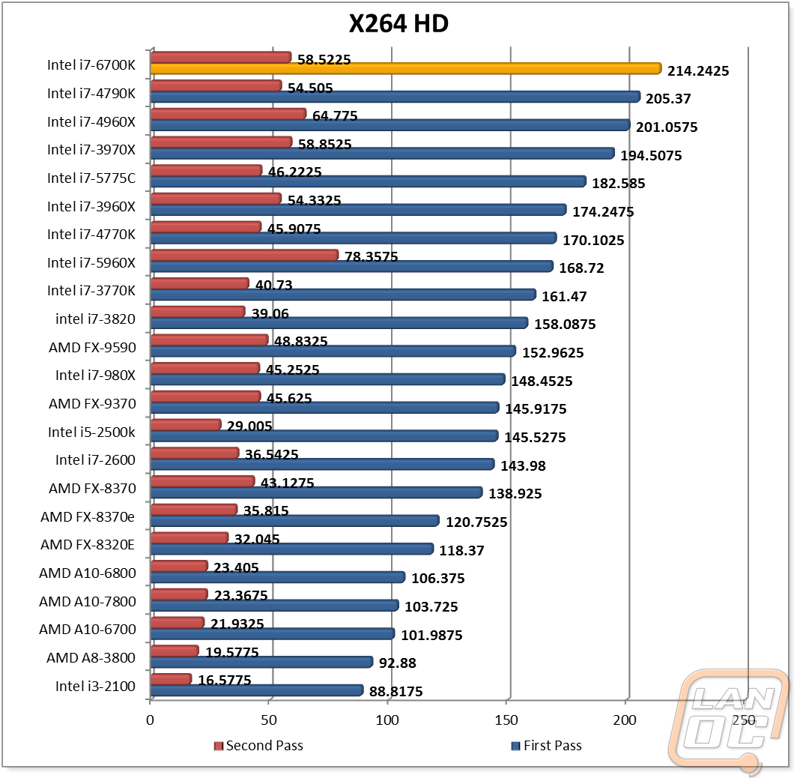
Next I tested using Cinebench, my favorite benchmark. I like this benchmark because it lets us see both a total CPU score as well as a single core score. The single core result is a great way to compare architures, especially when comparing between the 6/8 cores to the 2/4 cores. Here in the whole CPU result we have the 6700K up over the 4790K but still a little behind all of the modern Intel 6 cores going all the way back to the 3960X that is a little old now. The single core result really puts it all in perspective though, the 6700K is the fastest single core result with only the higher clocked 4790K coming close. In fact none of the others tested are even close (1.69 to 2.05). I also included the newer R15 results as I am slowly moving to that as our benchmark. The results are similar in it as well.
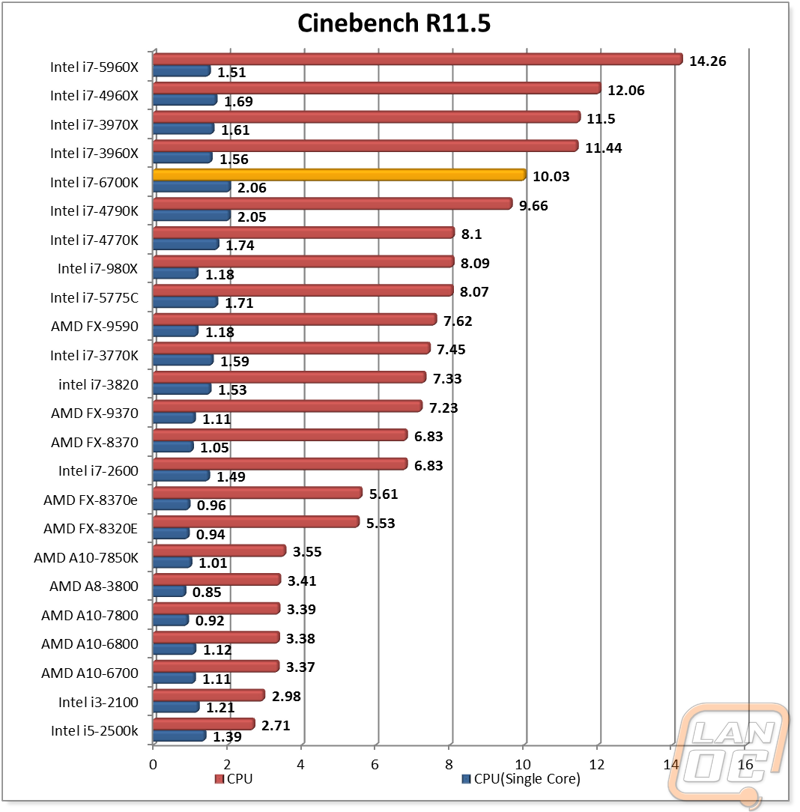
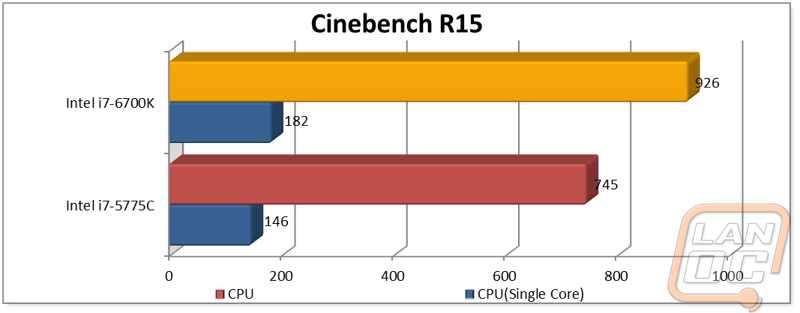
Next in Passmark 8 I use the total CPU score to test a variety of the synthetic CPU benchmarks. Here we see that the 6/8 cores are still favored but I was surprised to see the 4790K up ahead slightly as well given our results up until now. I guess the higher clock speeds helped.
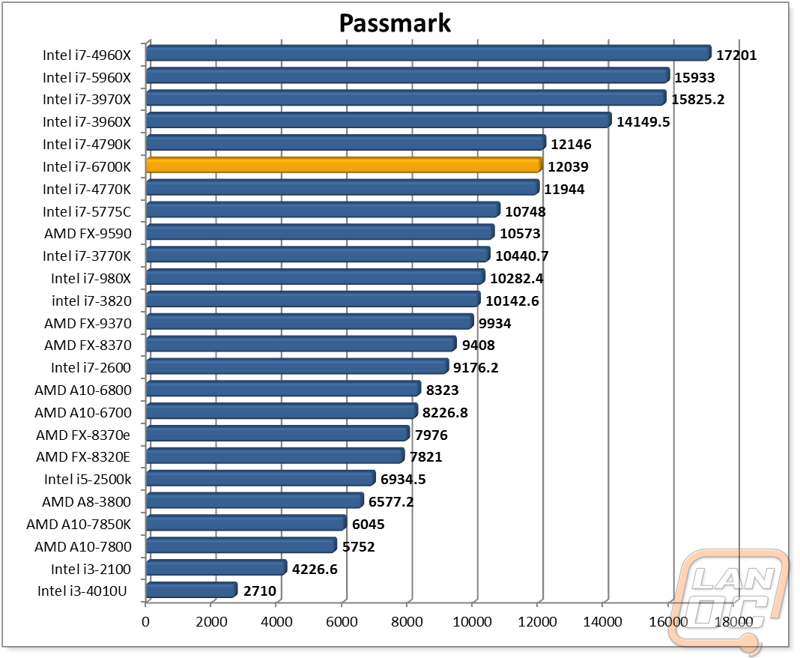
Next for real world results I use PCMark 8 as it tests using video playback, browser usage, and word processing for most of its testing. Here we see that the 4790K with its higher clock speed still outperforms in some situations. It’s clear that PCMark 8 favors high clock speeds given how high the FX 9590 ranks as well.
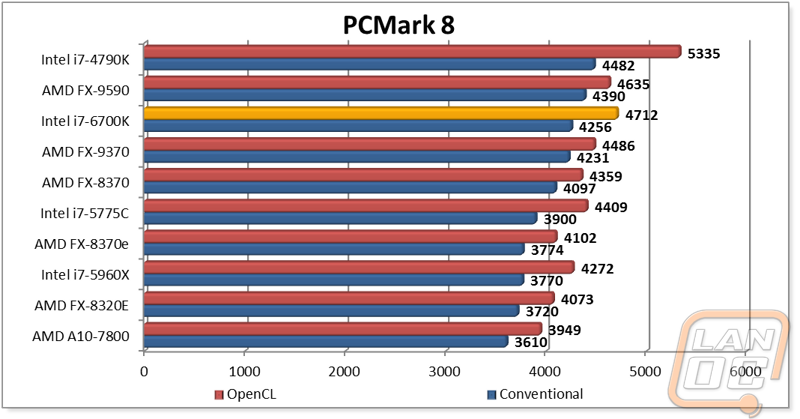
Next I tested with wPrime as a good math compute benchmark. Here the 8 core 5960X dominates but the 6700K does surprisingly well in a firm second place.
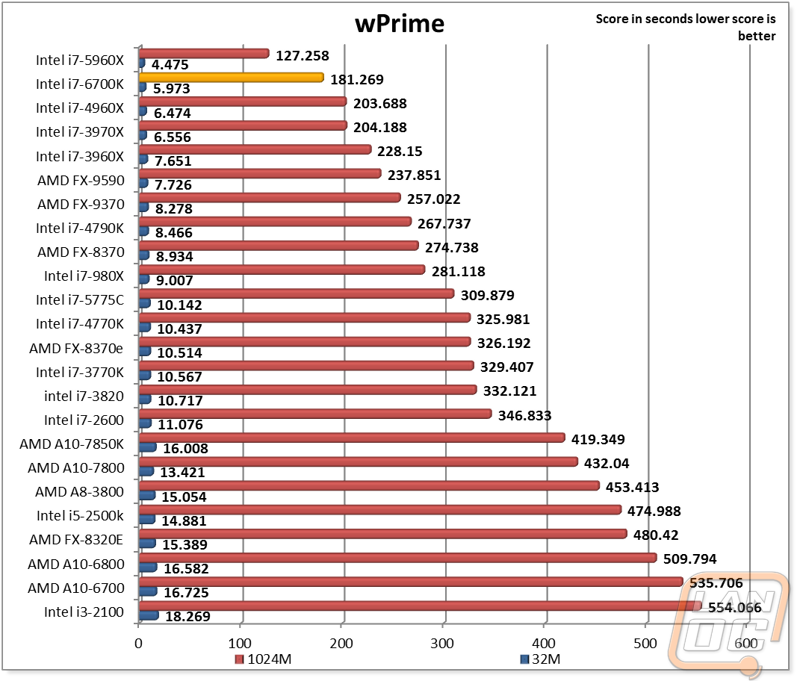
Next I test using 3DMark Fire Strike benchmark but to keep it focused on the CPUs performance and not on GPU driver changes I only focus on the physics score. No big surprises here, the 6700K comes in just below the 4790K as well as the 6/8 core Intel’s but is well above everything AMD has as well as the recent 5775C.
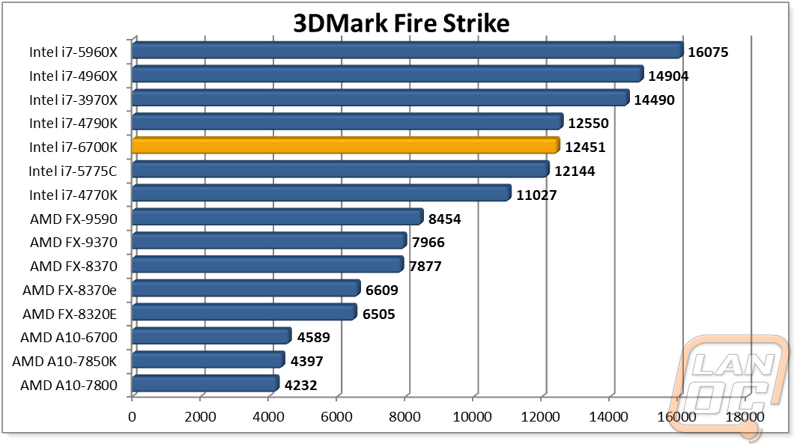
Last but not least I run through a few different modern games to see how much if at all the CPU effects actual in game performance. In some games like Bioshock and Hitman the CPU plays a big role. The others hardly change from CPU to CPU. Even then Bioshock seems to be more dependent on clock speeds and Hitman favors more cores. The 6700K performs well in both but the one weird result is that 5775C actually outperforming the 6700K in Bioshock.
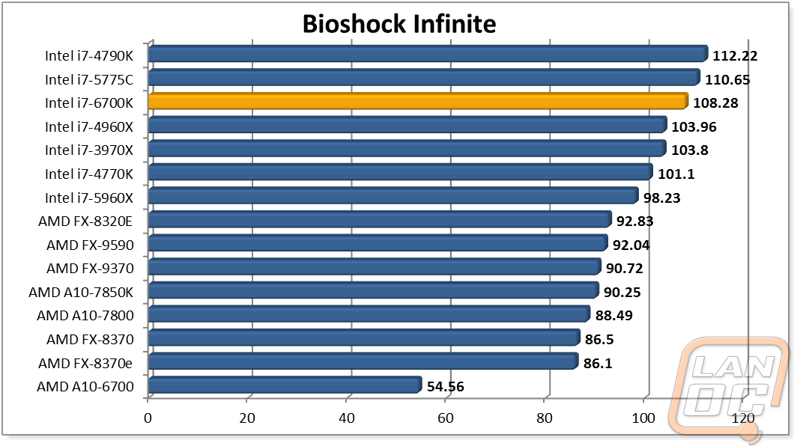
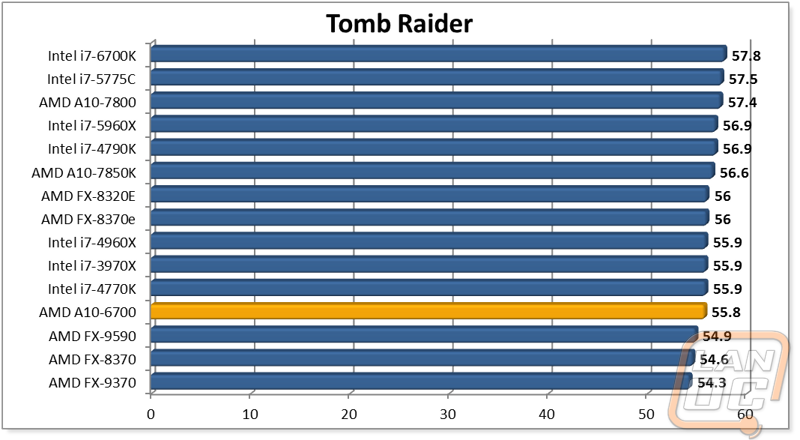
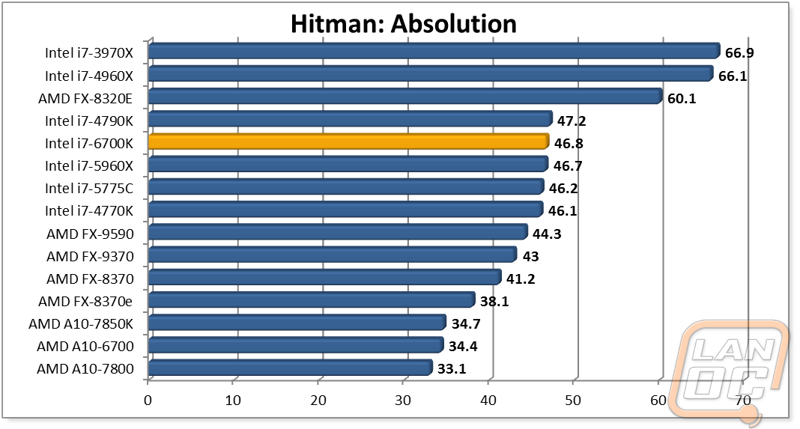
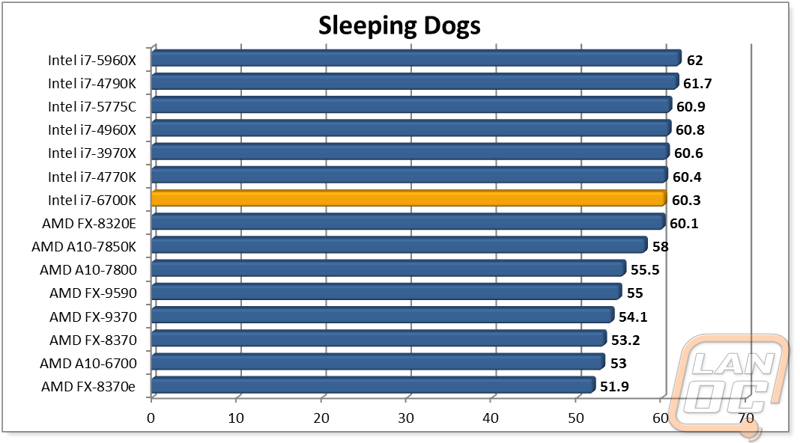
Onboard GPU Performance
In the past the Intel onboard graphics did what they needed to do but for a while AMDs APUs were performing better. That changed completely with the introduction of the i7-5775C though so going into this I was really curious how the Intel HD Graphics 530 GPU would perform on the 6700K. Intel designed this to be an enthusiast focused product so they didn’t go with the Iris GPU but given the improvement with the 5775C I still have high hopes. So to start things off I ran through both Cinebench R11.5 and R15 using the OpenGL benchmark that renders a video and the score is the average FPS. It’s no surprise that the i7-6700K didn’t outperform the 5775C but I was still impressed with the jump in performance over the 4790K and even the AMD 7850K with a second dedicated GPU in crossfire.
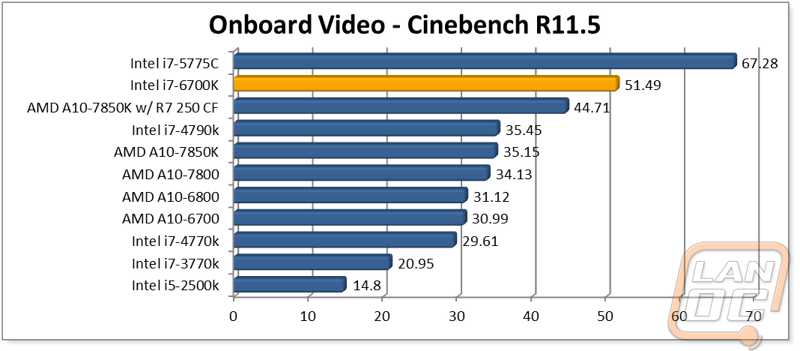

Next I ran through 3DMark Fire Strike, unlike our CPU testing we go for the overall score this time around so the CPU performance is just as important as the onboard GPU. So how did the 6700K perform? Well as expected the 5775C was up near the top but this time around the 6700K didn’t outperform AMDs Kaveri APUs with them edging out a slight lead.
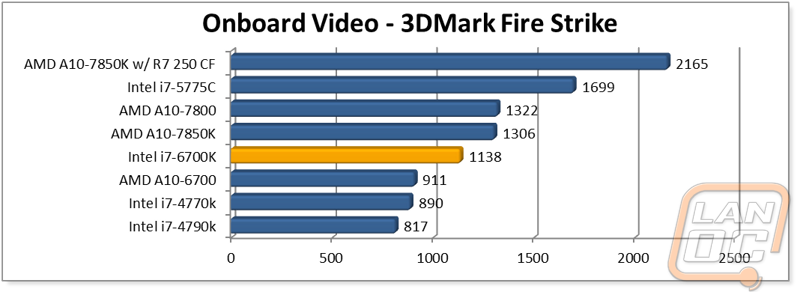
Next I ran through both Unigine based benchmarks, Heaven Benchmark 4.0 and Valley Benchmark 1.0. Both are run on their highest settings and frankly none of the onboard GPUs can really handle them at those settings. The 6700K did match the Kaveri APU performance with the 5775C pulling a nice lead with an additional 3 FPS average.
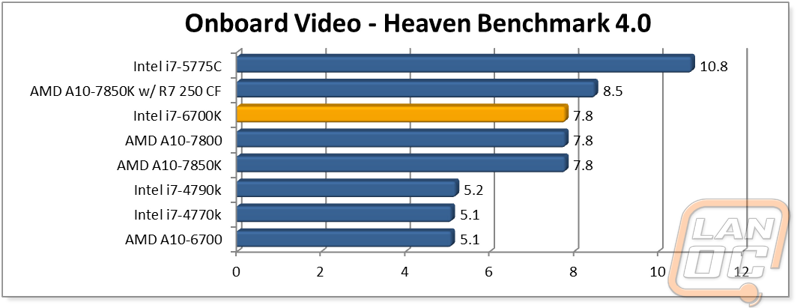

While we know that onboard performance isn’t exactly the best choice when you are trying to game, I was curious just how well the i7-6700K would perform if you had to wait for a few days for a dedicated GPU to come in. To do that I ran a variety of games, in most cases the games were set to their medium settings and run at 1080p. A few of the games fell flat on their face, as expected. But some of the games like both racing games, Tomb Raider, and even Sleeping Dogs all would be considered playable but not perfect. These are demanding games meaning less demanding games like the ever popular League of Legends would be more than playable on the 6700K although I personally would be looking for a dedicated GPU to match the 6700K’s CPU performance.
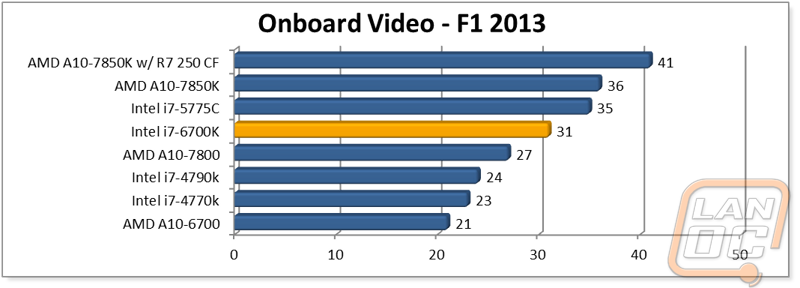

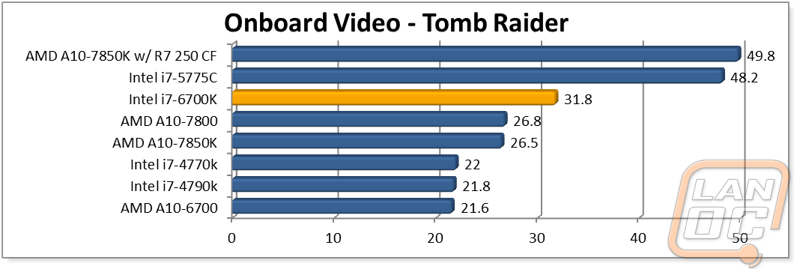
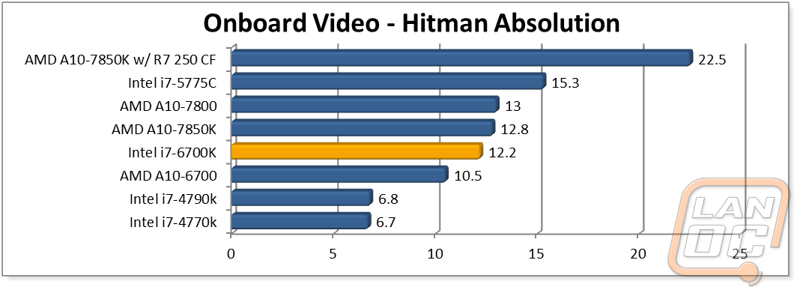
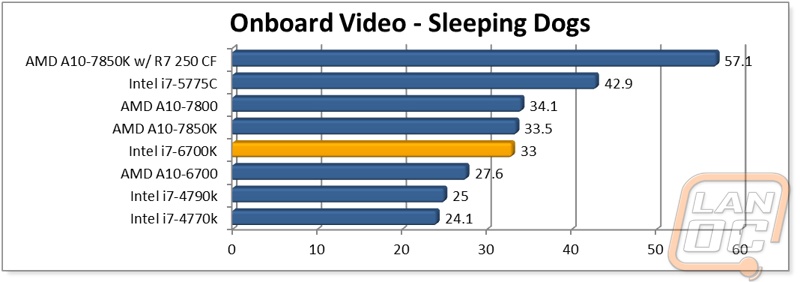

Overclocking, Cooling, and Power
While the performance numbers are important, there are other situations were you have to keep in mind other factors about a CPU. A good example of this is when you are building a small form factor build. The small size of most SFF builds means you have to be very aware of heat cooling and in addition to that you have to make sure everything will run on the power supplies that you can fit in your build. Because of this I make sure to test all of the CPUs that come through the office both for their power usage as well as how cool they run. For cooling testing I run Prime95 and see just how warm the CPU runs with our Noctua heatsink on it. I was a little surprised that the 6700K ran warmer than the 4790K given its high clock speed. Even so at 60 degrees it was still 20 degrees cooler than the high clock speed FX processors from AMD. While I don’t like the idea of the Intel CPUs running warm, I can’t really call it hot with that as the competition.
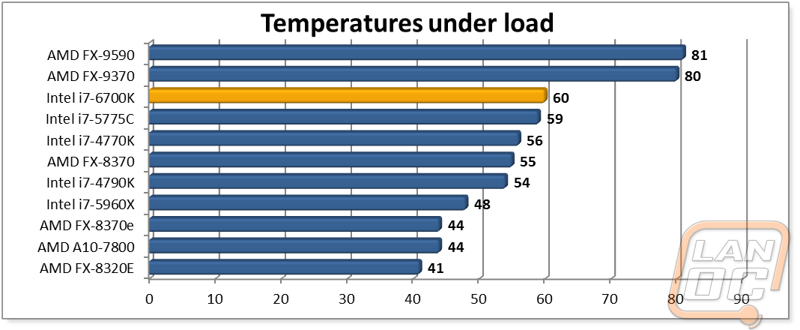
For power usage I use a Kill-A-Watt to track the overall power consumption of our entire test rig while testing. This includes the GTX 780, cooler, and drives in addition to the CPU. I let the test bench idle to reach the idle load and then I turn on wPrime to put the CPU under a realistic load (prime95 isn’t really realistic) and get our 100% cpu load wattage. The 6700K pulled 108 watts under load and 45.9 at idle. This is slightly more than the 4790K but still well under the competition.
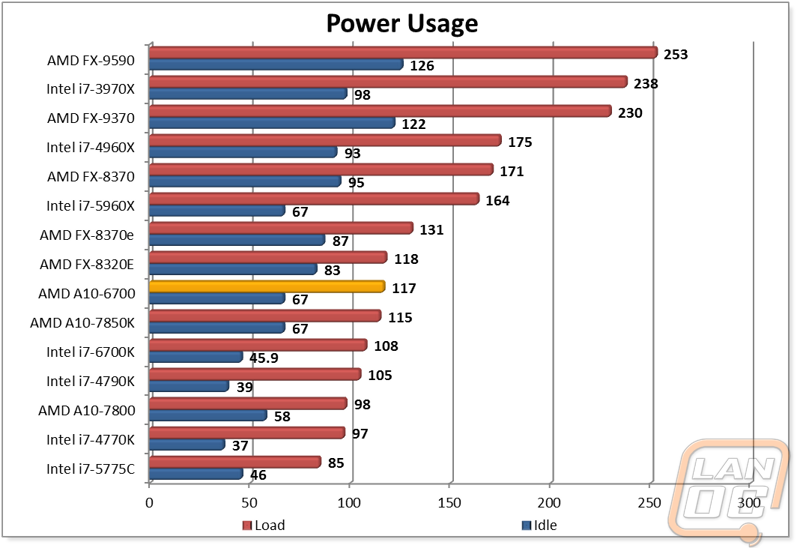
The last bit of testing I did was more for my own interest than anything else. I wanted to see just how well the new enthusiast CPU would overclock. To do this I jumped in Intel’s Extreme Tuning Utility and started to toy with it. Keep in mind this is still on air but I was able to bump the 6700K up to 4.7 GHz without having to feed it any voltage. I’m really looking forward to toying with voltage and seeing what it can really do. From my initial testing I would be surprised if I couldn’t push at least 5GHz on air. The overclocking fans are going to love this one! This is where the improved overclocking capabilities are really going to come in handy. With the 6700K you can change the BCLK in single increments where the 4790K was ratio based. The new DDR4 memory also opens up overclocking capabilities as well with up to 4133MHz officially supported. They also allowed for finer adjustments on the memory clock as well.
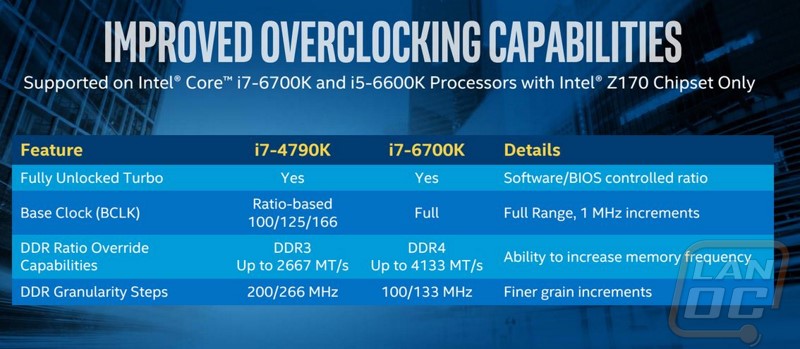
Overall and Final Verdict
So at the end of the day how did the i7-6700K/Skylake perform? Well on the CPU side of things it performed about how you would expect. It was an overall improvement from the i7-4790K in most tests but a few tests that favor higher clock speeds still had the 4790K edging ahead slightly. Because of that I can’t say this is above and beyond the only option to go with, the i7-4790K is aging very well due to its clock speed. That said I do love that they jumped right into Skylake with a proper CPU for enthusiasts and gamers. Their focus on that market was made especially clear with the introduction being at Gamescom and with the improvements to overclocking.
I was a little disappointed to see the onboard performance drop when compared to the i7-5775C, but given the enthusiast focus of this CPU it isn’t that big of a surprise. I can’t imagine a lot of people who want a higher end CPU like the 6700K wouldn’t pair it up with a proper dedicated GPU as well if they decide to game. The other downside, and this was an issue with the 5775C as well, was the 6700K running a little warmer than past CPUs in my testing. I wouldn’t call it hot, but I don’t like seeing Intel trend in that direction.
So is this the CPU for you? Well I really thing that it will depend on what you are looking to do for your next build. While the 6700K supports both DDR4 and DDR3 I think if you aren’t planning on going DDR4 that the 4790K and a Z97 board might still be the better option. But if you are building a completely new rig from scratch Intel has introduced two new CPUs that should be up at the top of your list. Not to mention going with the new Z170 boards will get your hands on a little new tech like USB-C. Now that we have USB-C in the office I think I might have to start looking around at what I can actually plug into it, then unplug it again and flip it over and plug it back in again. Over and over.
